The Gig Economy: HR Benefits and Challenges for Organizations
VerifiedAdded on 2020/04/07
|14
|3493
|74
Report
AI Summary
This report provides a detailed analysis of the gig economy, examining its operational aspects, benefits, and challenges for organizations, with a specific focus on HR implications. It explores the rise of the gig economy, driven by digital platforms and changing employment patterns, and discusses how it impacts traditional business models. The report outlines the advantages of the gig economy, such as flexibility in wages, reduced labor costs, and the ability to quickly adjust employment based on demand. It also addresses the challenges, including the need for agile HR responses, potential reductions in productivity, and the erosion of employee attachment and income security. The report further discusses HR's role in adapting to new labor laws, leadership development, and managing a global workforce. Recommendations are provided for companies like Uber to leverage the gig economy effectively, concluding with the importance of proactive HR strategies to navigate the evolving landscape.
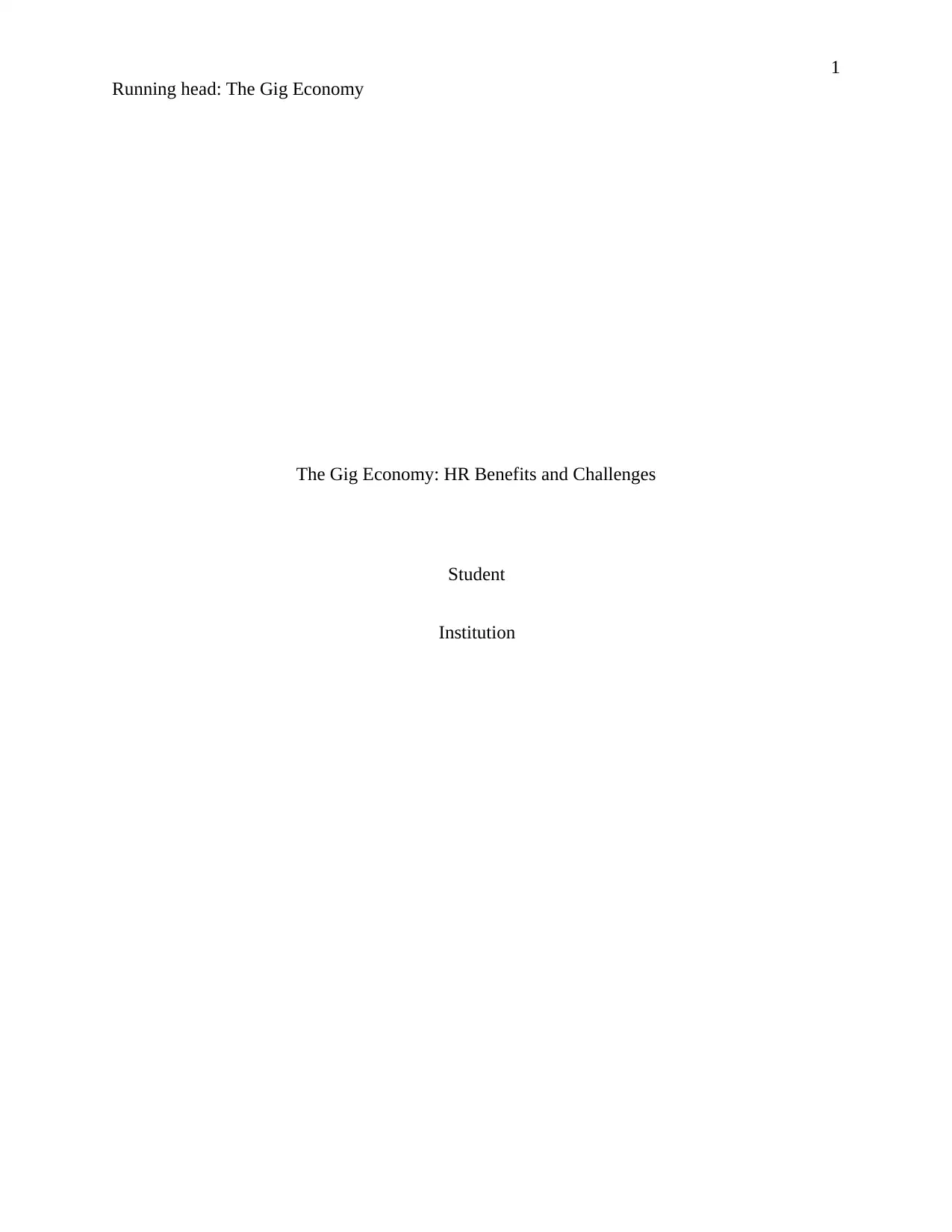
1
Running head: The Gig Economy
The Gig Economy: HR Benefits and Challenges
Student
Institution
Running head: The Gig Economy
The Gig Economy: HR Benefits and Challenges
Student
Institution
Paraphrase This Document
Need a fresh take? Get an instant paraphrase of this document with our AI Paraphraser
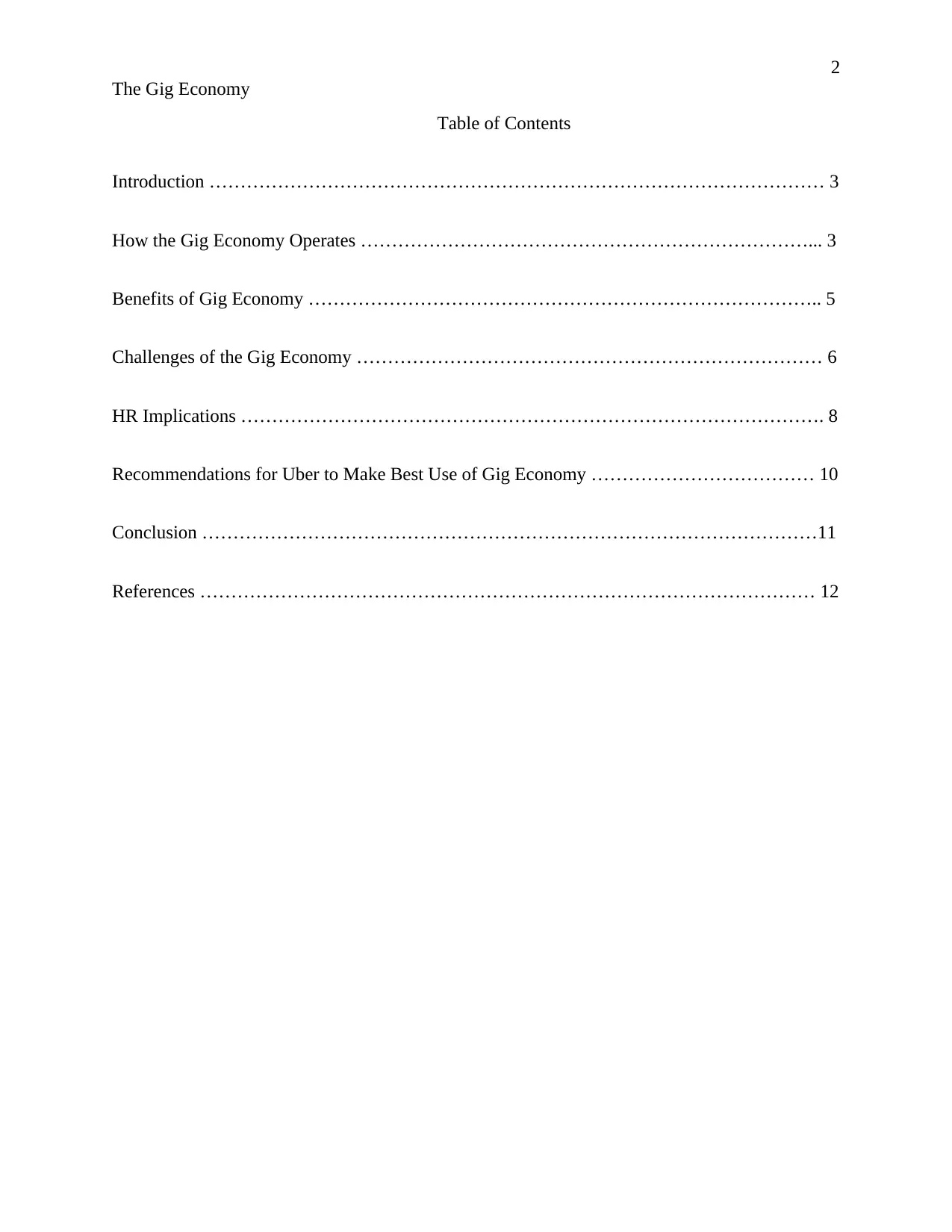
2
The Gig Economy
Table of Contents
Introduction ……………………………………………………………………………………… 3
How the Gig Economy Operates ………………………………………………………………... 3
Benefits of Gig Economy ……………………………………………………………………….. 5
Challenges of the Gig Economy ………………………………………………………………… 6
HR Implications …………………………………………………………………………………. 8
Recommendations for Uber to Make Best Use of Gig Economy ……………………………… 10
Conclusion ………………………………………………………………………………………11
References ……………………………………………………………………………………… 12
The Gig Economy
Table of Contents
Introduction ……………………………………………………………………………………… 3
How the Gig Economy Operates ………………………………………………………………... 3
Benefits of Gig Economy ……………………………………………………………………….. 5
Challenges of the Gig Economy ………………………………………………………………… 6
HR Implications …………………………………………………………………………………. 8
Recommendations for Uber to Make Best Use of Gig Economy ……………………………… 10
Conclusion ………………………………………………………………………………………11
References ……………………………………………………………………………………… 12
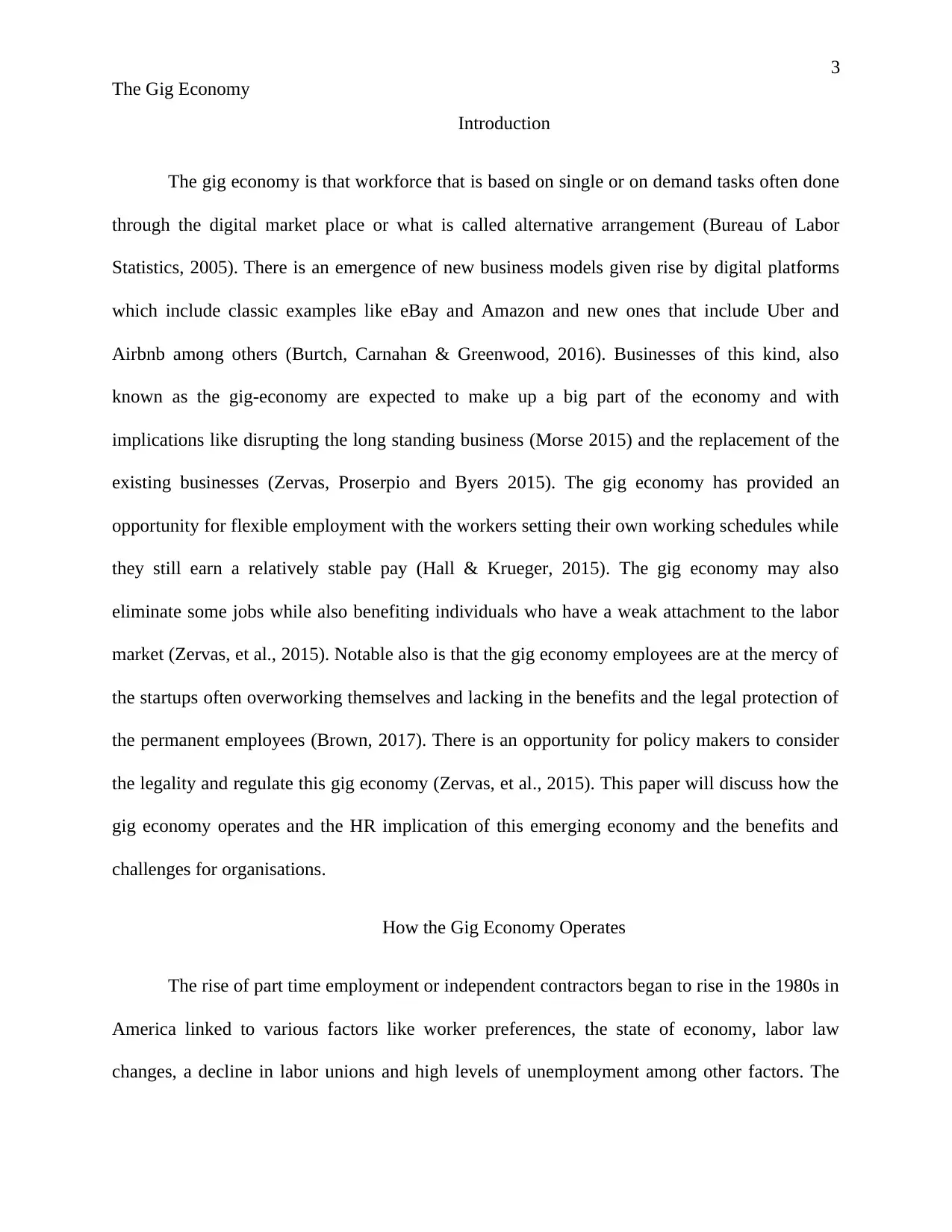
3
The Gig Economy
Introduction
The gig economy is that workforce that is based on single or on demand tasks often done
through the digital market place or what is called alternative arrangement (Bureau of Labor
Statistics, 2005). There is an emergence of new business models given rise by digital platforms
which include classic examples like eBay and Amazon and new ones that include Uber and
Airbnb among others (Burtch, Carnahan & Greenwood, 2016). Businesses of this kind, also
known as the gig-economy are expected to make up a big part of the economy and with
implications like disrupting the long standing business (Morse 2015) and the replacement of the
existing businesses (Zervas, Proserpio and Byers 2015). The gig economy has provided an
opportunity for flexible employment with the workers setting their own working schedules while
they still earn a relatively stable pay (Hall & Krueger, 2015). The gig economy may also
eliminate some jobs while also benefiting individuals who have a weak attachment to the labor
market (Zervas, et al., 2015). Notable also is that the gig economy employees are at the mercy of
the startups often overworking themselves and lacking in the benefits and the legal protection of
the permanent employees (Brown, 2017). There is an opportunity for policy makers to consider
the legality and regulate this gig economy (Zervas, et al., 2015). This paper will discuss how the
gig economy operates and the HR implication of this emerging economy and the benefits and
challenges for organisations.
How the Gig Economy Operates
The rise of part time employment or independent contractors began to rise in the 1980s in
America linked to various factors like worker preferences, the state of economy, labor law
changes, a decline in labor unions and high levels of unemployment among other factors. The
The Gig Economy
Introduction
The gig economy is that workforce that is based on single or on demand tasks often done
through the digital market place or what is called alternative arrangement (Bureau of Labor
Statistics, 2005). There is an emergence of new business models given rise by digital platforms
which include classic examples like eBay and Amazon and new ones that include Uber and
Airbnb among others (Burtch, Carnahan & Greenwood, 2016). Businesses of this kind, also
known as the gig-economy are expected to make up a big part of the economy and with
implications like disrupting the long standing business (Morse 2015) and the replacement of the
existing businesses (Zervas, Proserpio and Byers 2015). The gig economy has provided an
opportunity for flexible employment with the workers setting their own working schedules while
they still earn a relatively stable pay (Hall & Krueger, 2015). The gig economy may also
eliminate some jobs while also benefiting individuals who have a weak attachment to the labor
market (Zervas, et al., 2015). Notable also is that the gig economy employees are at the mercy of
the startups often overworking themselves and lacking in the benefits and the legal protection of
the permanent employees (Brown, 2017). There is an opportunity for policy makers to consider
the legality and regulate this gig economy (Zervas, et al., 2015). This paper will discuss how the
gig economy operates and the HR implication of this emerging economy and the benefits and
challenges for organisations.
How the Gig Economy Operates
The rise of part time employment or independent contractors began to rise in the 1980s in
America linked to various factors like worker preferences, the state of economy, labor law
changes, a decline in labor unions and high levels of unemployment among other factors. The
⊘ This is a preview!⊘
Do you want full access?
Subscribe today to unlock all pages.

Trusted by 1+ million students worldwide
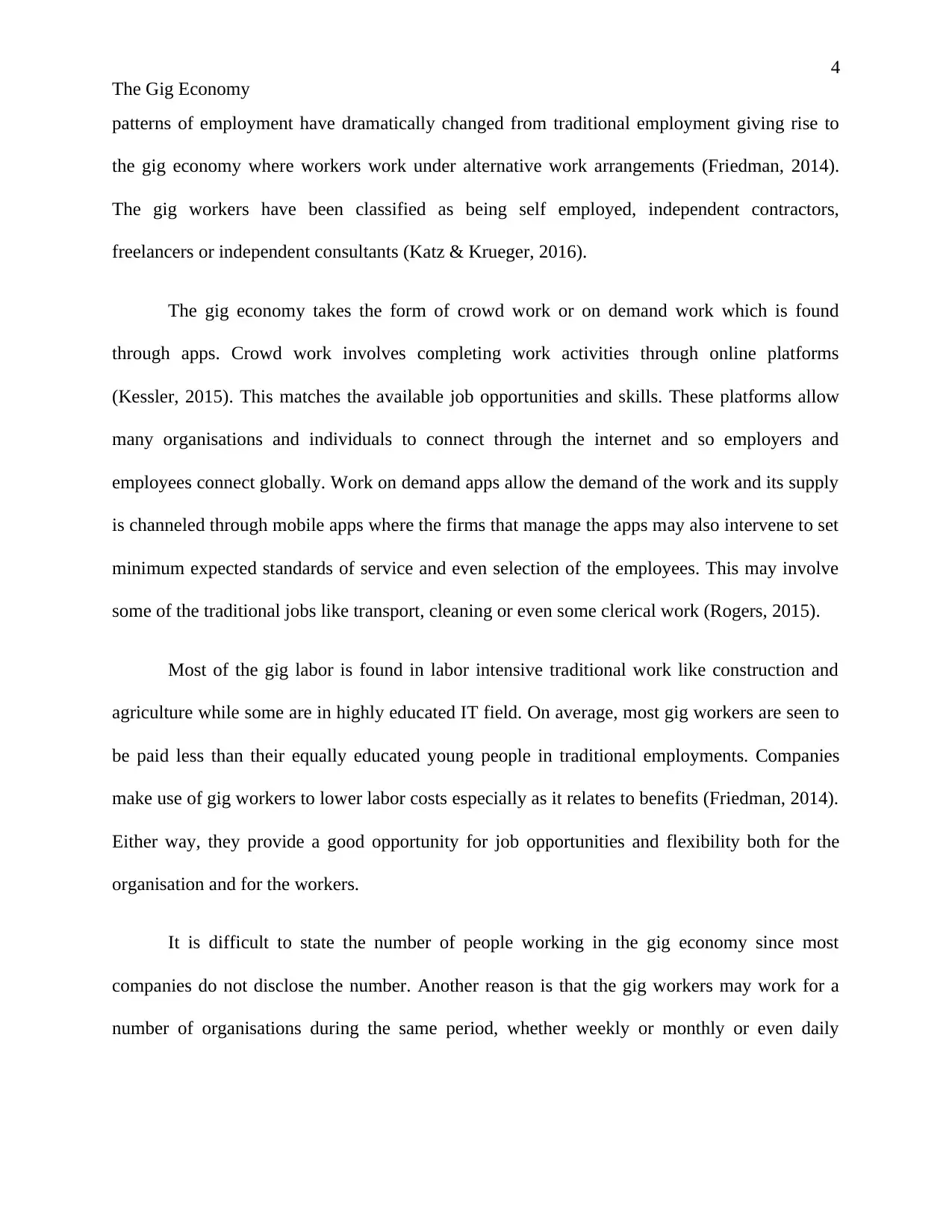
4
The Gig Economy
patterns of employment have dramatically changed from traditional employment giving rise to
the gig economy where workers work under alternative work arrangements (Friedman, 2014).
The gig workers have been classified as being self employed, independent contractors,
freelancers or independent consultants (Katz & Krueger, 2016).
The gig economy takes the form of crowd work or on demand work which is found
through apps. Crowd work involves completing work activities through online platforms
(Kessler, 2015). This matches the available job opportunities and skills. These platforms allow
many organisations and individuals to connect through the internet and so employers and
employees connect globally. Work on demand apps allow the demand of the work and its supply
is channeled through mobile apps where the firms that manage the apps may also intervene to set
minimum expected standards of service and even selection of the employees. This may involve
some of the traditional jobs like transport, cleaning or even some clerical work (Rogers, 2015).
Most of the gig labor is found in labor intensive traditional work like construction and
agriculture while some are in highly educated IT field. On average, most gig workers are seen to
be paid less than their equally educated young people in traditional employments. Companies
make use of gig workers to lower labor costs especially as it relates to benefits (Friedman, 2014).
Either way, they provide a good opportunity for job opportunities and flexibility both for the
organisation and for the workers.
It is difficult to state the number of people working in the gig economy since most
companies do not disclose the number. Another reason is that the gig workers may work for a
number of organisations during the same period, whether weekly or monthly or even daily
The Gig Economy
patterns of employment have dramatically changed from traditional employment giving rise to
the gig economy where workers work under alternative work arrangements (Friedman, 2014).
The gig workers have been classified as being self employed, independent contractors,
freelancers or independent consultants (Katz & Krueger, 2016).
The gig economy takes the form of crowd work or on demand work which is found
through apps. Crowd work involves completing work activities through online platforms
(Kessler, 2015). This matches the available job opportunities and skills. These platforms allow
many organisations and individuals to connect through the internet and so employers and
employees connect globally. Work on demand apps allow the demand of the work and its supply
is channeled through mobile apps where the firms that manage the apps may also intervene to set
minimum expected standards of service and even selection of the employees. This may involve
some of the traditional jobs like transport, cleaning or even some clerical work (Rogers, 2015).
Most of the gig labor is found in labor intensive traditional work like construction and
agriculture while some are in highly educated IT field. On average, most gig workers are seen to
be paid less than their equally educated young people in traditional employments. Companies
make use of gig workers to lower labor costs especially as it relates to benefits (Friedman, 2014).
Either way, they provide a good opportunity for job opportunities and flexibility both for the
organisation and for the workers.
It is difficult to state the number of people working in the gig economy since most
companies do not disclose the number. Another reason is that the gig workers may work for a
number of organisations during the same period, whether weekly or monthly or even daily
Paraphrase This Document
Need a fresh take? Get an instant paraphrase of this document with our AI Paraphraser
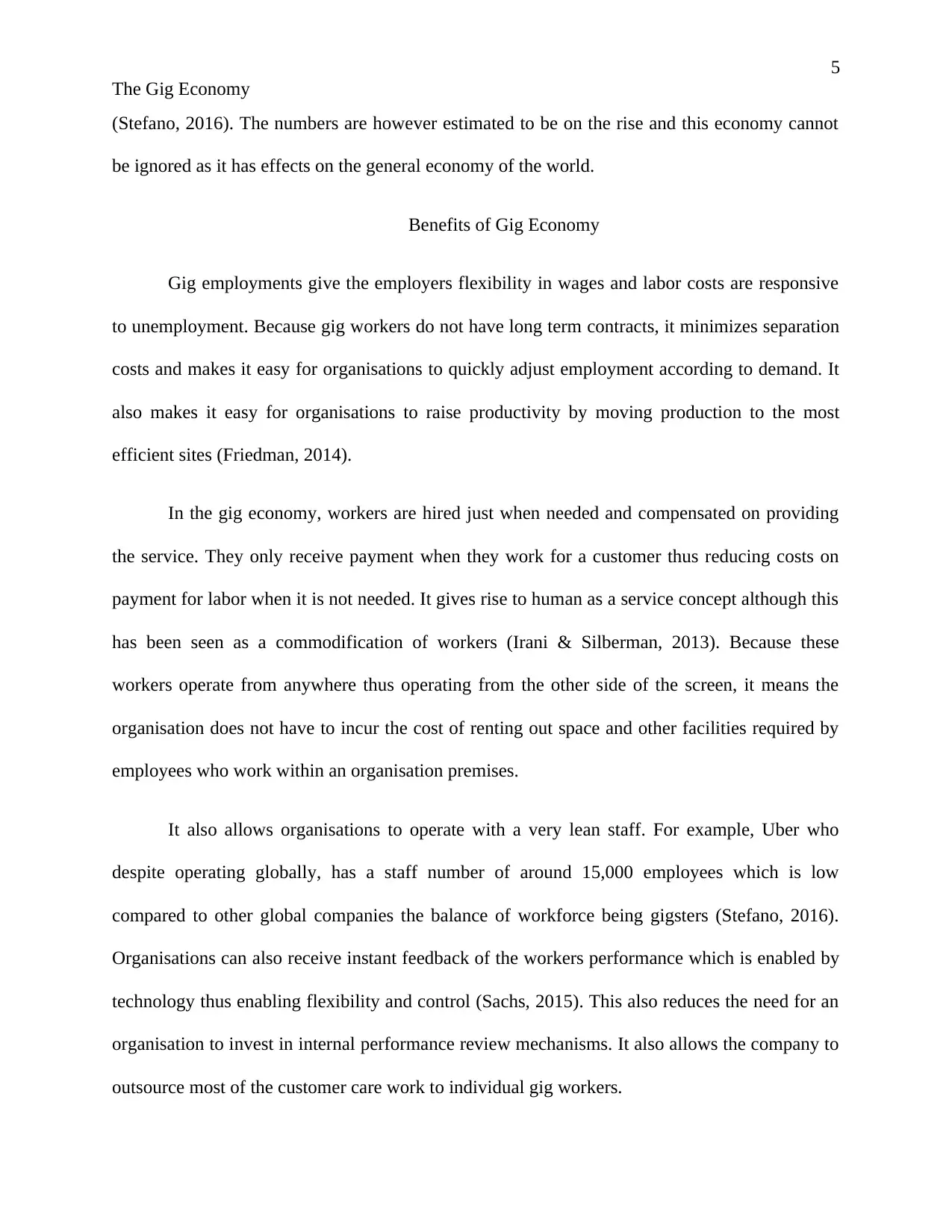
5
The Gig Economy
(Stefano, 2016). The numbers are however estimated to be on the rise and this economy cannot
be ignored as it has effects on the general economy of the world.
Benefits of Gig Economy
Gig employments give the employers flexibility in wages and labor costs are responsive
to unemployment. Because gig workers do not have long term contracts, it minimizes separation
costs and makes it easy for organisations to quickly adjust employment according to demand. It
also makes it easy for organisations to raise productivity by moving production to the most
efficient sites (Friedman, 2014).
In the gig economy, workers are hired just when needed and compensated on providing
the service. They only receive payment when they work for a customer thus reducing costs on
payment for labor when it is not needed. It gives rise to human as a service concept although this
has been seen as a commodification of workers (Irani & Silberman, 2013). Because these
workers operate from anywhere thus operating from the other side of the screen, it means the
organisation does not have to incur the cost of renting out space and other facilities required by
employees who work within an organisation premises.
It also allows organisations to operate with a very lean staff. For example, Uber who
despite operating globally, has a staff number of around 15,000 employees which is low
compared to other global companies the balance of workforce being gigsters (Stefano, 2016).
Organisations can also receive instant feedback of the workers performance which is enabled by
technology thus enabling flexibility and control (Sachs, 2015). This also reduces the need for an
organisation to invest in internal performance review mechanisms. It also allows the company to
outsource most of the customer care work to individual gig workers.
The Gig Economy
(Stefano, 2016). The numbers are however estimated to be on the rise and this economy cannot
be ignored as it has effects on the general economy of the world.
Benefits of Gig Economy
Gig employments give the employers flexibility in wages and labor costs are responsive
to unemployment. Because gig workers do not have long term contracts, it minimizes separation
costs and makes it easy for organisations to quickly adjust employment according to demand. It
also makes it easy for organisations to raise productivity by moving production to the most
efficient sites (Friedman, 2014).
In the gig economy, workers are hired just when needed and compensated on providing
the service. They only receive payment when they work for a customer thus reducing costs on
payment for labor when it is not needed. It gives rise to human as a service concept although this
has been seen as a commodification of workers (Irani & Silberman, 2013). Because these
workers operate from anywhere thus operating from the other side of the screen, it means the
organisation does not have to incur the cost of renting out space and other facilities required by
employees who work within an organisation premises.
It also allows organisations to operate with a very lean staff. For example, Uber who
despite operating globally, has a staff number of around 15,000 employees which is low
compared to other global companies the balance of workforce being gigsters (Stefano, 2016).
Organisations can also receive instant feedback of the workers performance which is enabled by
technology thus enabling flexibility and control (Sachs, 2015). This also reduces the need for an
organisation to invest in internal performance review mechanisms. It also allows the company to
outsource most of the customer care work to individual gig workers.
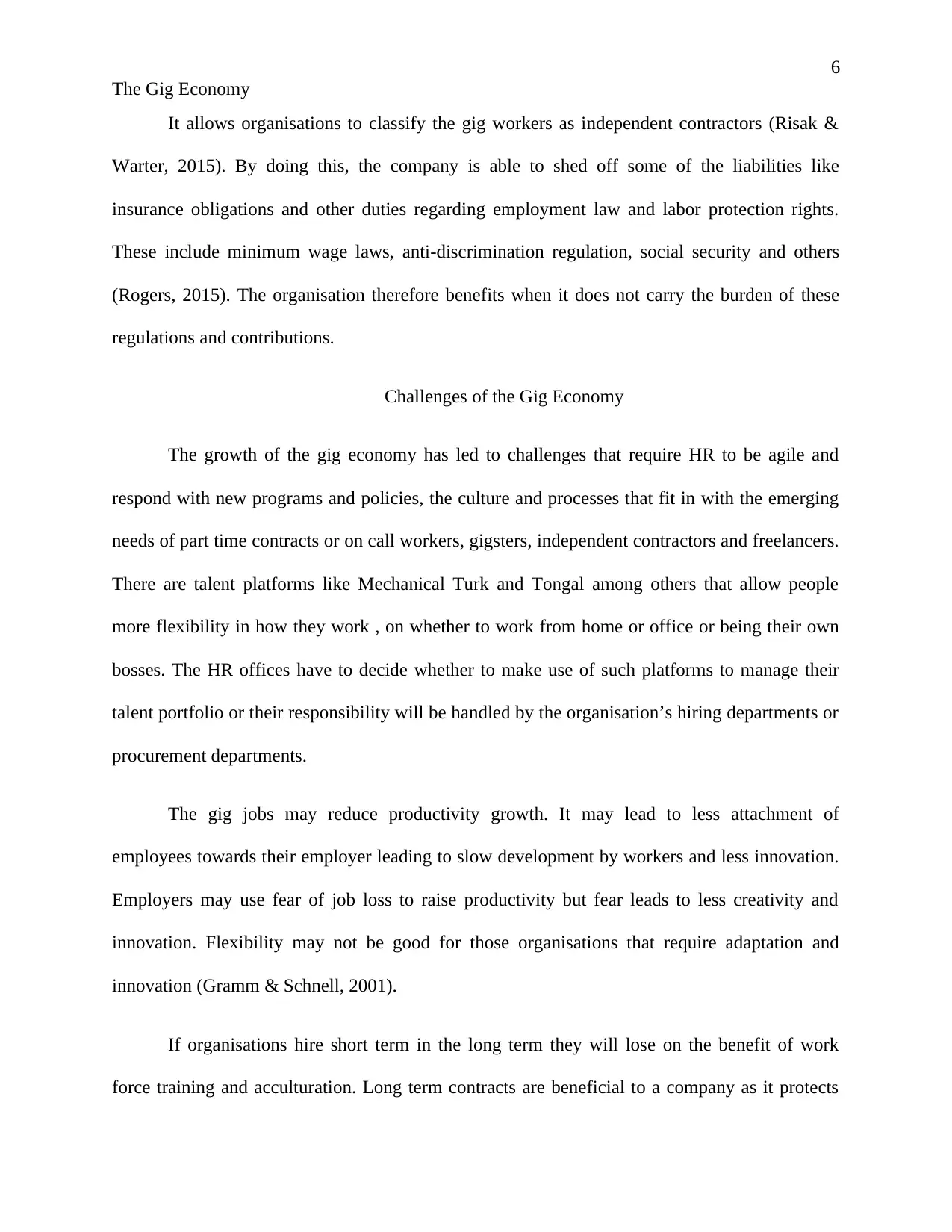
6
The Gig Economy
It allows organisations to classify the gig workers as independent contractors (Risak &
Warter, 2015). By doing this, the company is able to shed off some of the liabilities like
insurance obligations and other duties regarding employment law and labor protection rights.
These include minimum wage laws, anti-discrimination regulation, social security and others
(Rogers, 2015). The organisation therefore benefits when it does not carry the burden of these
regulations and contributions.
Challenges of the Gig Economy
The growth of the gig economy has led to challenges that require HR to be agile and
respond with new programs and policies, the culture and processes that fit in with the emerging
needs of part time contracts or on call workers, gigsters, independent contractors and freelancers.
There are talent platforms like Mechanical Turk and Tongal among others that allow people
more flexibility in how they work , on whether to work from home or office or being their own
bosses. The HR offices have to decide whether to make use of such platforms to manage their
talent portfolio or their responsibility will be handled by the organisation’s hiring departments or
procurement departments.
The gig jobs may reduce productivity growth. It may lead to less attachment of
employees towards their employer leading to slow development by workers and less innovation.
Employers may use fear of job loss to raise productivity but fear leads to less creativity and
innovation. Flexibility may not be good for those organisations that require adaptation and
innovation (Gramm & Schnell, 2001).
If organisations hire short term in the long term they will lose on the benefit of work
force training and acculturation. Long term contracts are beneficial to a company as it protects
The Gig Economy
It allows organisations to classify the gig workers as independent contractors (Risak &
Warter, 2015). By doing this, the company is able to shed off some of the liabilities like
insurance obligations and other duties regarding employment law and labor protection rights.
These include minimum wage laws, anti-discrimination regulation, social security and others
(Rogers, 2015). The organisation therefore benefits when it does not carry the burden of these
regulations and contributions.
Challenges of the Gig Economy
The growth of the gig economy has led to challenges that require HR to be agile and
respond with new programs and policies, the culture and processes that fit in with the emerging
needs of part time contracts or on call workers, gigsters, independent contractors and freelancers.
There are talent platforms like Mechanical Turk and Tongal among others that allow people
more flexibility in how they work , on whether to work from home or office or being their own
bosses. The HR offices have to decide whether to make use of such platforms to manage their
talent portfolio or their responsibility will be handled by the organisation’s hiring departments or
procurement departments.
The gig jobs may reduce productivity growth. It may lead to less attachment of
employees towards their employer leading to slow development by workers and less innovation.
Employers may use fear of job loss to raise productivity but fear leads to less creativity and
innovation. Flexibility may not be good for those organisations that require adaptation and
innovation (Gramm & Schnell, 2001).
If organisations hire short term in the long term they will lose on the benefit of work
force training and acculturation. Long term contracts are beneficial to a company as it protects
⊘ This is a preview!⊘
Do you want full access?
Subscribe today to unlock all pages.

Trusted by 1+ million students worldwide
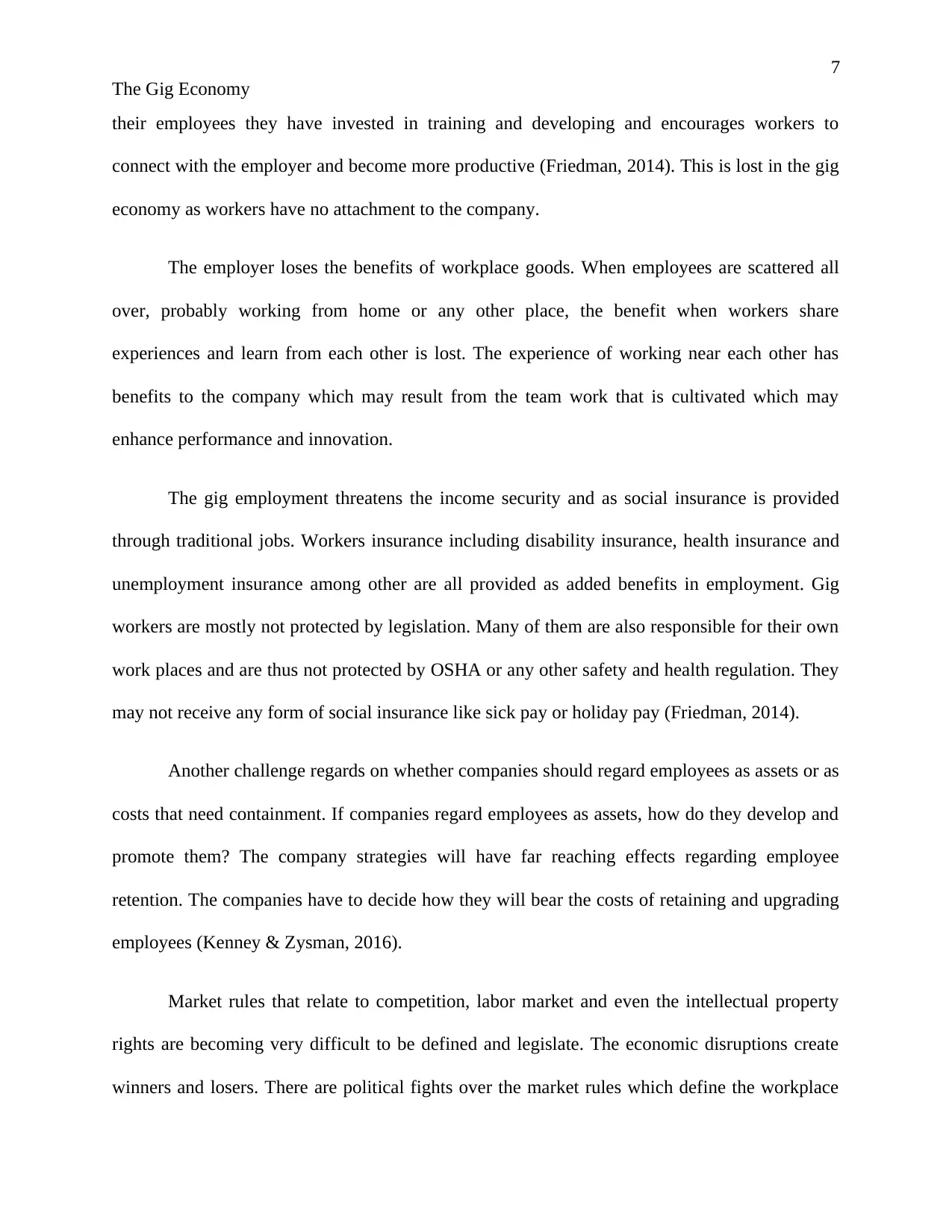
7
The Gig Economy
their employees they have invested in training and developing and encourages workers to
connect with the employer and become more productive (Friedman, 2014). This is lost in the gig
economy as workers have no attachment to the company.
The employer loses the benefits of workplace goods. When employees are scattered all
over, probably working from home or any other place, the benefit when workers share
experiences and learn from each other is lost. The experience of working near each other has
benefits to the company which may result from the team work that is cultivated which may
enhance performance and innovation.
The gig employment threatens the income security and as social insurance is provided
through traditional jobs. Workers insurance including disability insurance, health insurance and
unemployment insurance among other are all provided as added benefits in employment. Gig
workers are mostly not protected by legislation. Many of them are also responsible for their own
work places and are thus not protected by OSHA or any other safety and health regulation. They
may not receive any form of social insurance like sick pay or holiday pay (Friedman, 2014).
Another challenge regards on whether companies should regard employees as assets or as
costs that need containment. If companies regard employees as assets, how do they develop and
promote them? The company strategies will have far reaching effects regarding employee
retention. The companies have to decide how they will bear the costs of retaining and upgrading
employees (Kenney & Zysman, 2016).
Market rules that relate to competition, labor market and even the intellectual property
rights are becoming very difficult to be defined and legislate. The economic disruptions create
winners and losers. There are political fights over the market rules which define the workplace
The Gig Economy
their employees they have invested in training and developing and encourages workers to
connect with the employer and become more productive (Friedman, 2014). This is lost in the gig
economy as workers have no attachment to the company.
The employer loses the benefits of workplace goods. When employees are scattered all
over, probably working from home or any other place, the benefit when workers share
experiences and learn from each other is lost. The experience of working near each other has
benefits to the company which may result from the team work that is cultivated which may
enhance performance and innovation.
The gig employment threatens the income security and as social insurance is provided
through traditional jobs. Workers insurance including disability insurance, health insurance and
unemployment insurance among other are all provided as added benefits in employment. Gig
workers are mostly not protected by legislation. Many of them are also responsible for their own
work places and are thus not protected by OSHA or any other safety and health regulation. They
may not receive any form of social insurance like sick pay or holiday pay (Friedman, 2014).
Another challenge regards on whether companies should regard employees as assets or as
costs that need containment. If companies regard employees as assets, how do they develop and
promote them? The company strategies will have far reaching effects regarding employee
retention. The companies have to decide how they will bear the costs of retaining and upgrading
employees (Kenney & Zysman, 2016).
Market rules that relate to competition, labor market and even the intellectual property
rights are becoming very difficult to be defined and legislate. The economic disruptions create
winners and losers. There are political fights over the market rules which define the workplace
Paraphrase This Document
Need a fresh take? Get an instant paraphrase of this document with our AI Paraphraser
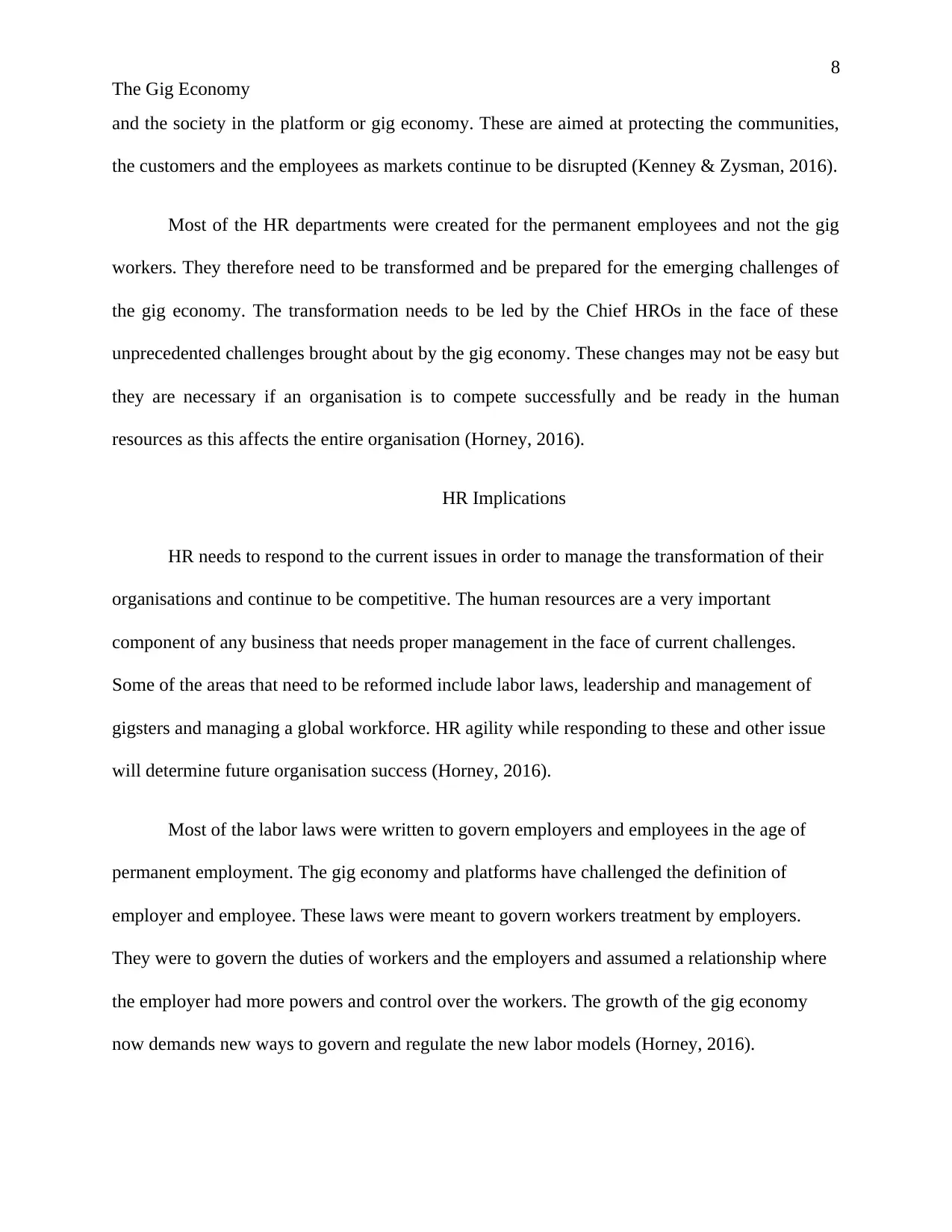
8
The Gig Economy
and the society in the platform or gig economy. These are aimed at protecting the communities,
the customers and the employees as markets continue to be disrupted (Kenney & Zysman, 2016).
Most of the HR departments were created for the permanent employees and not the gig
workers. They therefore need to be transformed and be prepared for the emerging challenges of
the gig economy. The transformation needs to be led by the Chief HROs in the face of these
unprecedented challenges brought about by the gig economy. These changes may not be easy but
they are necessary if an organisation is to compete successfully and be ready in the human
resources as this affects the entire organisation (Horney, 2016).
HR Implications
HR needs to respond to the current issues in order to manage the transformation of their
organisations and continue to be competitive. The human resources are a very important
component of any business that needs proper management in the face of current challenges.
Some of the areas that need to be reformed include labor laws, leadership and management of
gigsters and managing a global workforce. HR agility while responding to these and other issue
will determine future organisation success (Horney, 2016).
Most of the labor laws were written to govern employers and employees in the age of
permanent employment. The gig economy and platforms have challenged the definition of
employer and employee. These laws were meant to govern workers treatment by employers.
They were to govern the duties of workers and the employers and assumed a relationship where
the employer had more powers and control over the workers. The growth of the gig economy
now demands new ways to govern and regulate the new labor models (Horney, 2016).
The Gig Economy
and the society in the platform or gig economy. These are aimed at protecting the communities,
the customers and the employees as markets continue to be disrupted (Kenney & Zysman, 2016).
Most of the HR departments were created for the permanent employees and not the gig
workers. They therefore need to be transformed and be prepared for the emerging challenges of
the gig economy. The transformation needs to be led by the Chief HROs in the face of these
unprecedented challenges brought about by the gig economy. These changes may not be easy but
they are necessary if an organisation is to compete successfully and be ready in the human
resources as this affects the entire organisation (Horney, 2016).
HR Implications
HR needs to respond to the current issues in order to manage the transformation of their
organisations and continue to be competitive. The human resources are a very important
component of any business that needs proper management in the face of current challenges.
Some of the areas that need to be reformed include labor laws, leadership and management of
gigsters and managing a global workforce. HR agility while responding to these and other issue
will determine future organisation success (Horney, 2016).
Most of the labor laws were written to govern employers and employees in the age of
permanent employment. The gig economy and platforms have challenged the definition of
employer and employee. These laws were meant to govern workers treatment by employers.
They were to govern the duties of workers and the employers and assumed a relationship where
the employer had more powers and control over the workers. The growth of the gig economy
now demands new ways to govern and regulate the new labor models (Horney, 2016).
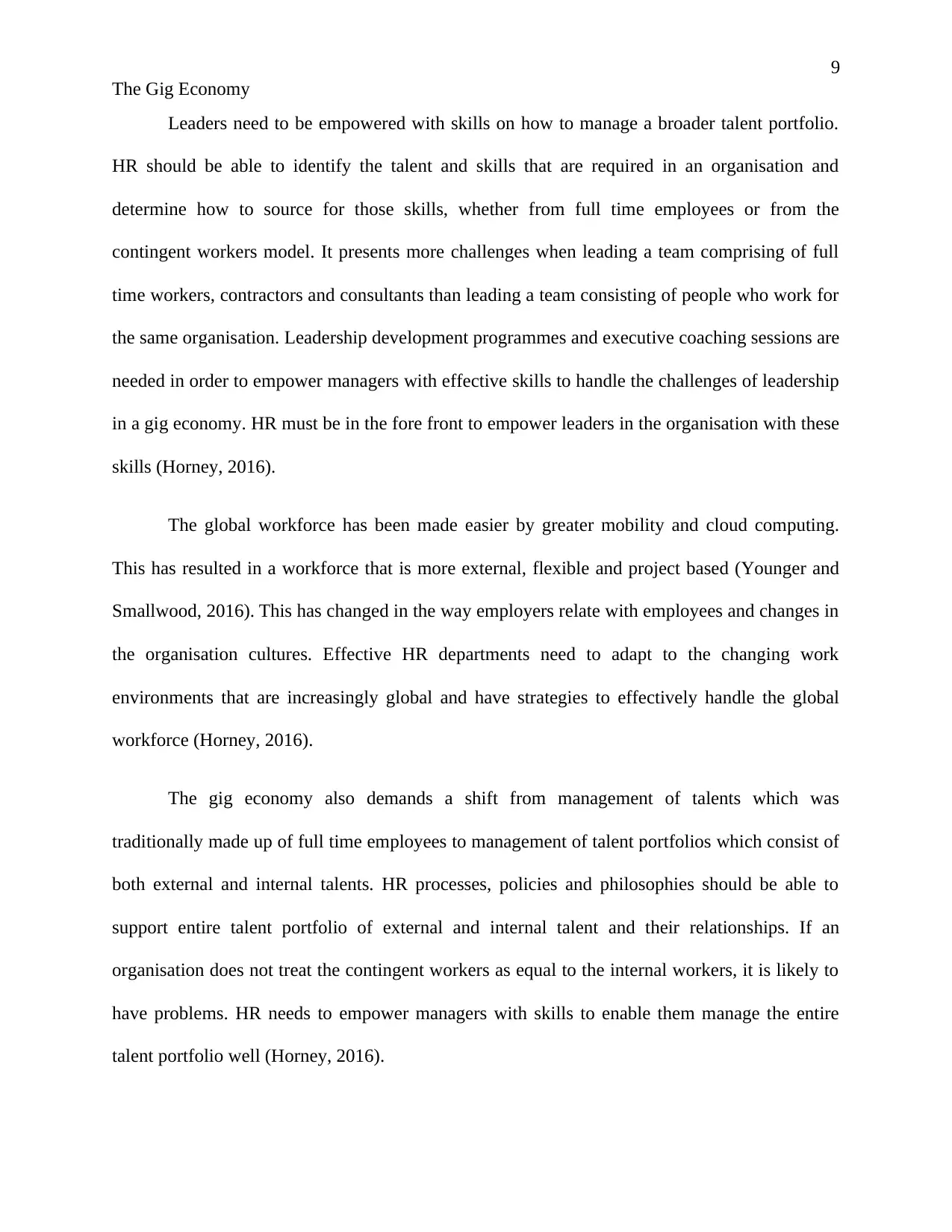
9
The Gig Economy
Leaders need to be empowered with skills on how to manage a broader talent portfolio.
HR should be able to identify the talent and skills that are required in an organisation and
determine how to source for those skills, whether from full time employees or from the
contingent workers model. It presents more challenges when leading a team comprising of full
time workers, contractors and consultants than leading a team consisting of people who work for
the same organisation. Leadership development programmes and executive coaching sessions are
needed in order to empower managers with effective skills to handle the challenges of leadership
in a gig economy. HR must be in the fore front to empower leaders in the organisation with these
skills (Horney, 2016).
The global workforce has been made easier by greater mobility and cloud computing.
This has resulted in a workforce that is more external, flexible and project based (Younger and
Smallwood, 2016). This has changed in the way employers relate with employees and changes in
the organisation cultures. Effective HR departments need to adapt to the changing work
environments that are increasingly global and have strategies to effectively handle the global
workforce (Horney, 2016).
The gig economy also demands a shift from management of talents which was
traditionally made up of full time employees to management of talent portfolios which consist of
both external and internal talents. HR processes, policies and philosophies should be able to
support entire talent portfolio of external and internal talent and their relationships. If an
organisation does not treat the contingent workers as equal to the internal workers, it is likely to
have problems. HR needs to empower managers with skills to enable them manage the entire
talent portfolio well (Horney, 2016).
The Gig Economy
Leaders need to be empowered with skills on how to manage a broader talent portfolio.
HR should be able to identify the talent and skills that are required in an organisation and
determine how to source for those skills, whether from full time employees or from the
contingent workers model. It presents more challenges when leading a team comprising of full
time workers, contractors and consultants than leading a team consisting of people who work for
the same organisation. Leadership development programmes and executive coaching sessions are
needed in order to empower managers with effective skills to handle the challenges of leadership
in a gig economy. HR must be in the fore front to empower leaders in the organisation with these
skills (Horney, 2016).
The global workforce has been made easier by greater mobility and cloud computing.
This has resulted in a workforce that is more external, flexible and project based (Younger and
Smallwood, 2016). This has changed in the way employers relate with employees and changes in
the organisation cultures. Effective HR departments need to adapt to the changing work
environments that are increasingly global and have strategies to effectively handle the global
workforce (Horney, 2016).
The gig economy also demands a shift from management of talents which was
traditionally made up of full time employees to management of talent portfolios which consist of
both external and internal talents. HR processes, policies and philosophies should be able to
support entire talent portfolio of external and internal talent and their relationships. If an
organisation does not treat the contingent workers as equal to the internal workers, it is likely to
have problems. HR needs to empower managers with skills to enable them manage the entire
talent portfolio well (Horney, 2016).
⊘ This is a preview!⊘
Do you want full access?
Subscribe today to unlock all pages.

Trusted by 1+ million students worldwide
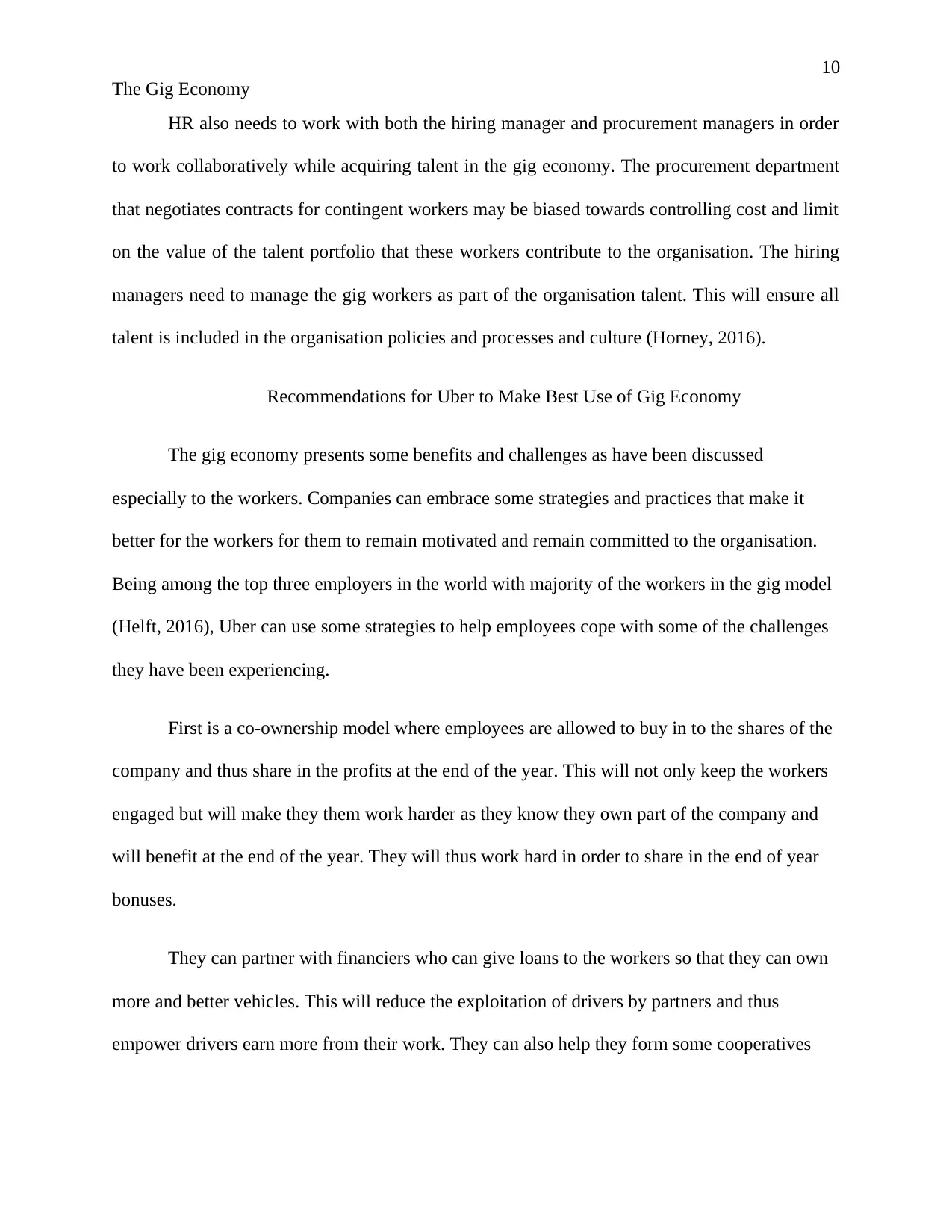
10
The Gig Economy
HR also needs to work with both the hiring manager and procurement managers in order
to work collaboratively while acquiring talent in the gig economy. The procurement department
that negotiates contracts for contingent workers may be biased towards controlling cost and limit
on the value of the talent portfolio that these workers contribute to the organisation. The hiring
managers need to manage the gig workers as part of the organisation talent. This will ensure all
talent is included in the organisation policies and processes and culture (Horney, 2016).
Recommendations for Uber to Make Best Use of Gig Economy
The gig economy presents some benefits and challenges as have been discussed
especially to the workers. Companies can embrace some strategies and practices that make it
better for the workers for them to remain motivated and remain committed to the organisation.
Being among the top three employers in the world with majority of the workers in the gig model
(Helft, 2016), Uber can use some strategies to help employees cope with some of the challenges
they have been experiencing.
First is a co-ownership model where employees are allowed to buy in to the shares of the
company and thus share in the profits at the end of the year. This will not only keep the workers
engaged but will make they them work harder as they know they own part of the company and
will benefit at the end of the year. They will thus work hard in order to share in the end of year
bonuses.
They can partner with financiers who can give loans to the workers so that they can own
more and better vehicles. This will reduce the exploitation of drivers by partners and thus
empower drivers earn more from their work. They can also help they form some cooperatives
The Gig Economy
HR also needs to work with both the hiring manager and procurement managers in order
to work collaboratively while acquiring talent in the gig economy. The procurement department
that negotiates contracts for contingent workers may be biased towards controlling cost and limit
on the value of the talent portfolio that these workers contribute to the organisation. The hiring
managers need to manage the gig workers as part of the organisation talent. This will ensure all
talent is included in the organisation policies and processes and culture (Horney, 2016).
Recommendations for Uber to Make Best Use of Gig Economy
The gig economy presents some benefits and challenges as have been discussed
especially to the workers. Companies can embrace some strategies and practices that make it
better for the workers for them to remain motivated and remain committed to the organisation.
Being among the top three employers in the world with majority of the workers in the gig model
(Helft, 2016), Uber can use some strategies to help employees cope with some of the challenges
they have been experiencing.
First is a co-ownership model where employees are allowed to buy in to the shares of the
company and thus share in the profits at the end of the year. This will not only keep the workers
engaged but will make they them work harder as they know they own part of the company and
will benefit at the end of the year. They will thus work hard in order to share in the end of year
bonuses.
They can partner with financiers who can give loans to the workers so that they can own
more and better vehicles. This will reduce the exploitation of drivers by partners and thus
empower drivers earn more from their work. They can also help they form some cooperatives
Paraphrase This Document
Need a fresh take? Get an instant paraphrase of this document with our AI Paraphraser
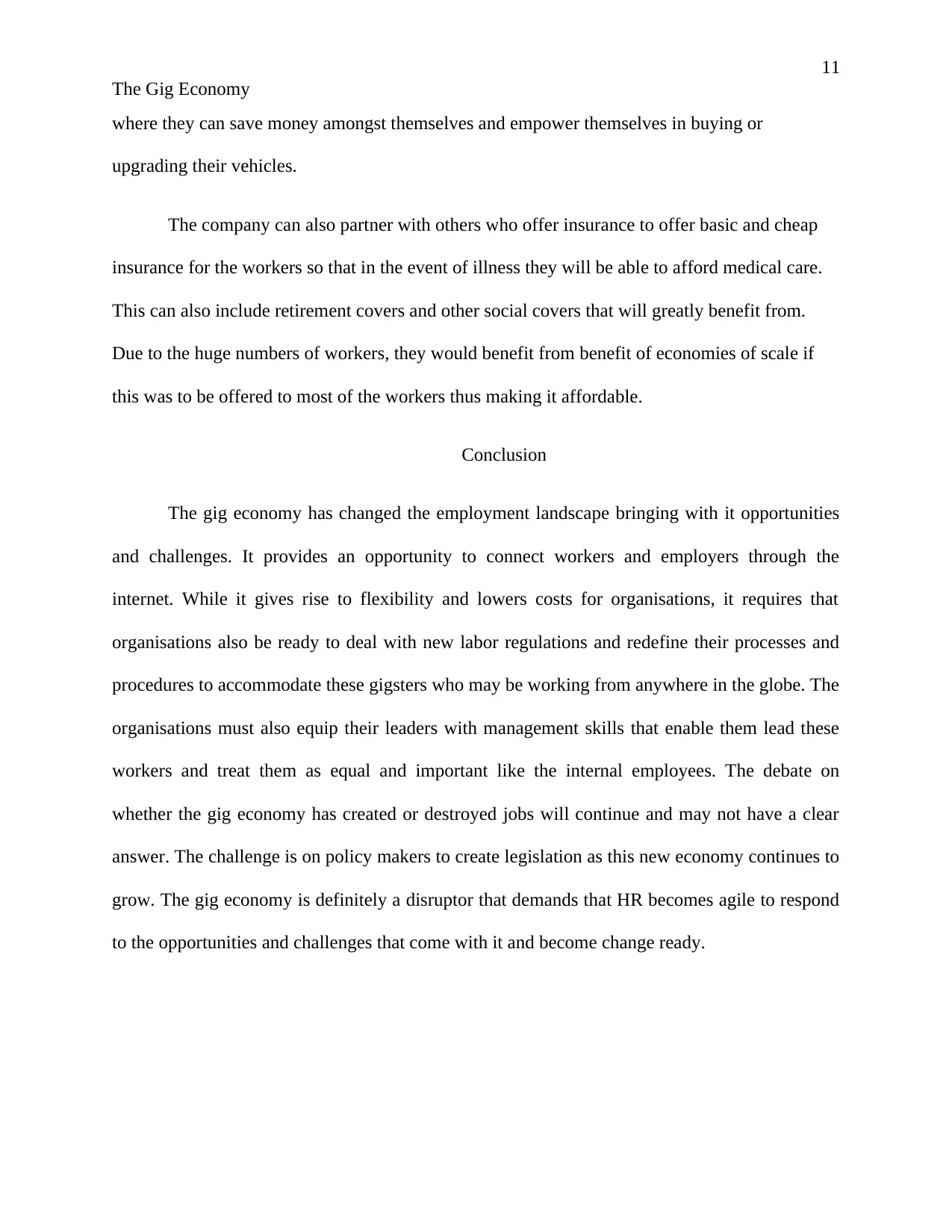
11
The Gig Economy
where they can save money amongst themselves and empower themselves in buying or
upgrading their vehicles.
The company can also partner with others who offer insurance to offer basic and cheap
insurance for the workers so that in the event of illness they will be able to afford medical care.
This can also include retirement covers and other social covers that will greatly benefit from.
Due to the huge numbers of workers, they would benefit from benefit of economies of scale if
this was to be offered to most of the workers thus making it affordable.
Conclusion
The gig economy has changed the employment landscape bringing with it opportunities
and challenges. It provides an opportunity to connect workers and employers through the
internet. While it gives rise to flexibility and lowers costs for organisations, it requires that
organisations also be ready to deal with new labor regulations and redefine their processes and
procedures to accommodate these gigsters who may be working from anywhere in the globe. The
organisations must also equip their leaders with management skills that enable them lead these
workers and treat them as equal and important like the internal employees. The debate on
whether the gig economy has created or destroyed jobs will continue and may not have a clear
answer. The challenge is on policy makers to create legislation as this new economy continues to
grow. The gig economy is definitely a disruptor that demands that HR becomes agile to respond
to the opportunities and challenges that come with it and become change ready.
The Gig Economy
where they can save money amongst themselves and empower themselves in buying or
upgrading their vehicles.
The company can also partner with others who offer insurance to offer basic and cheap
insurance for the workers so that in the event of illness they will be able to afford medical care.
This can also include retirement covers and other social covers that will greatly benefit from.
Due to the huge numbers of workers, they would benefit from benefit of economies of scale if
this was to be offered to most of the workers thus making it affordable.
Conclusion
The gig economy has changed the employment landscape bringing with it opportunities
and challenges. It provides an opportunity to connect workers and employers through the
internet. While it gives rise to flexibility and lowers costs for organisations, it requires that
organisations also be ready to deal with new labor regulations and redefine their processes and
procedures to accommodate these gigsters who may be working from anywhere in the globe. The
organisations must also equip their leaders with management skills that enable them lead these
workers and treat them as equal and important like the internal employees. The debate on
whether the gig economy has created or destroyed jobs will continue and may not have a clear
answer. The challenge is on policy makers to create legislation as this new economy continues to
grow. The gig economy is definitely a disruptor that demands that HR becomes agile to respond
to the opportunities and challenges that come with it and become change ready.
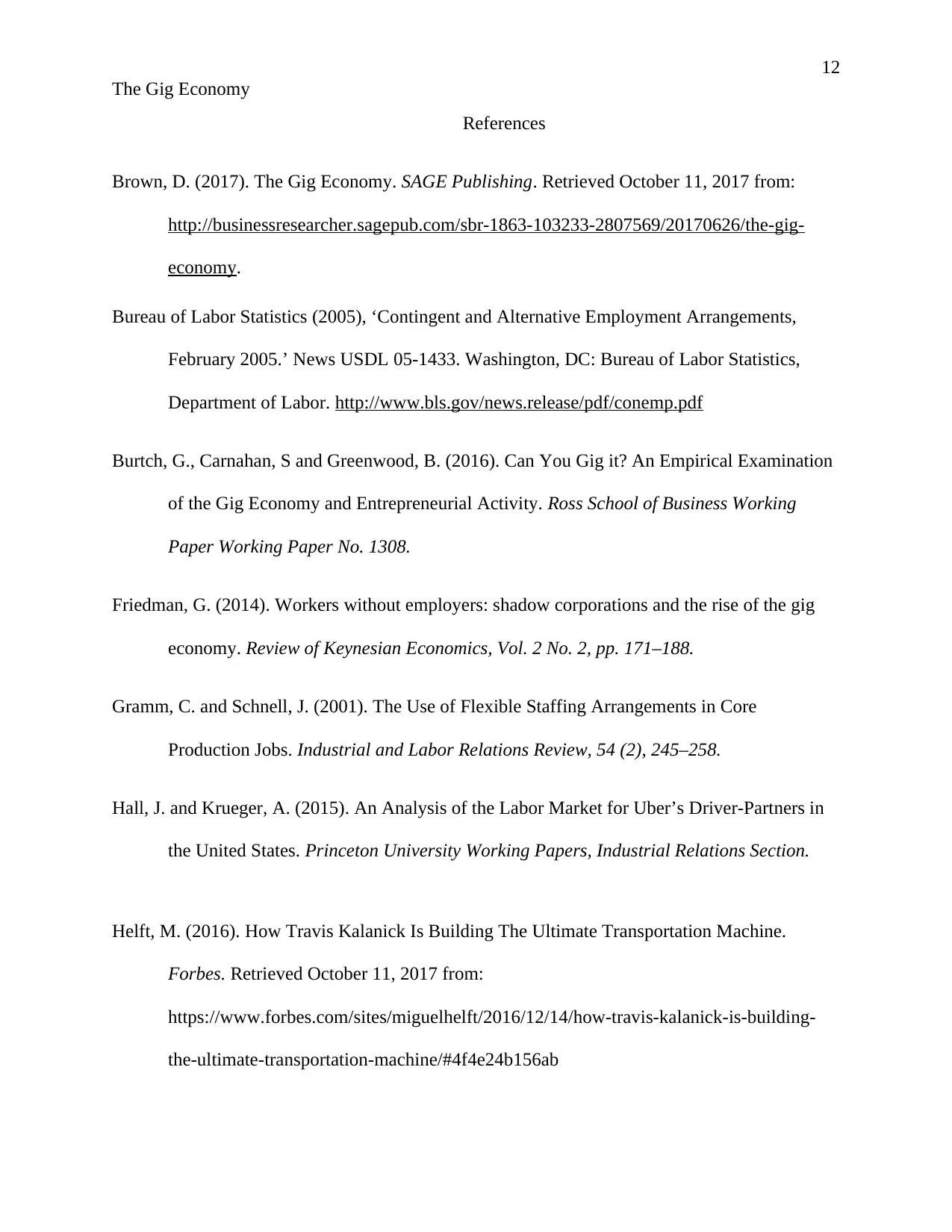
12
The Gig Economy
References
Brown, D. (2017). The Gig Economy. SAGE Publishing. Retrieved October 11, 2017 from:
http://businessresearcher.sagepub.com/sbr-1863-103233-2807569/20170626/the-gig-
economy.
Bureau of Labor Statistics (2005), ‘Contingent and Alternative Employment Arrangements,
February 2005.’ News USDL 05-1433. Washington, DC: Bureau of Labor Statistics,
Department of Labor. http://www.bls.gov/news.release/pdf/conemp.pdf
Burtch, G., Carnahan, S and Greenwood, B. (2016). Can You Gig it? An Empirical Examination
of the Gig Economy and Entrepreneurial Activity. Ross School of Business Working
Paper Working Paper No. 1308.
Friedman, G. (2014). Workers without employers: shadow corporations and the rise of the gig
economy. Review of Keynesian Economics, Vol. 2 No. 2, pp. 171–188.
Gramm, C. and Schnell, J. (2001). The Use of Flexible Staffing Arrangements in Core
Production Jobs. Industrial and Labor Relations Review, 54 (2), 245–258.
Hall, J. and Krueger, A. (2015). An Analysis of the Labor Market for Uber’s Driver-Partners in
the United States. Princeton University Working Papers, Industrial Relations Section.
Helft, M. (2016). How Travis Kalanick Is Building The Ultimate Transportation Machine.
Forbes. Retrieved October 11, 2017 from:
https://www.forbes.com/sites/miguelhelft/2016/12/14/how-travis-kalanick-is-building-
the-ultimate-transportation-machine/#4f4e24b156ab
The Gig Economy
References
Brown, D. (2017). The Gig Economy. SAGE Publishing. Retrieved October 11, 2017 from:
http://businessresearcher.sagepub.com/sbr-1863-103233-2807569/20170626/the-gig-
economy.
Bureau of Labor Statistics (2005), ‘Contingent and Alternative Employment Arrangements,
February 2005.’ News USDL 05-1433. Washington, DC: Bureau of Labor Statistics,
Department of Labor. http://www.bls.gov/news.release/pdf/conemp.pdf
Burtch, G., Carnahan, S and Greenwood, B. (2016). Can You Gig it? An Empirical Examination
of the Gig Economy and Entrepreneurial Activity. Ross School of Business Working
Paper Working Paper No. 1308.
Friedman, G. (2014). Workers without employers: shadow corporations and the rise of the gig
economy. Review of Keynesian Economics, Vol. 2 No. 2, pp. 171–188.
Gramm, C. and Schnell, J. (2001). The Use of Flexible Staffing Arrangements in Core
Production Jobs. Industrial and Labor Relations Review, 54 (2), 245–258.
Hall, J. and Krueger, A. (2015). An Analysis of the Labor Market for Uber’s Driver-Partners in
the United States. Princeton University Working Papers, Industrial Relations Section.
Helft, M. (2016). How Travis Kalanick Is Building The Ultimate Transportation Machine.
Forbes. Retrieved October 11, 2017 from:
https://www.forbes.com/sites/miguelhelft/2016/12/14/how-travis-kalanick-is-building-
the-ultimate-transportation-machine/#4f4e24b156ab
⊘ This is a preview!⊘
Do you want full access?
Subscribe today to unlock all pages.

Trusted by 1+ million students worldwide
1 out of 14
Related Documents
Your All-in-One AI-Powered Toolkit for Academic Success.
+13062052269
info@desklib.com
Available 24*7 on WhatsApp / Email
![[object Object]](/_next/static/media/star-bottom.7253800d.svg)
Unlock your academic potential
Copyright © 2020–2025 A2Z Services. All Rights Reserved. Developed and managed by ZUCOL.





